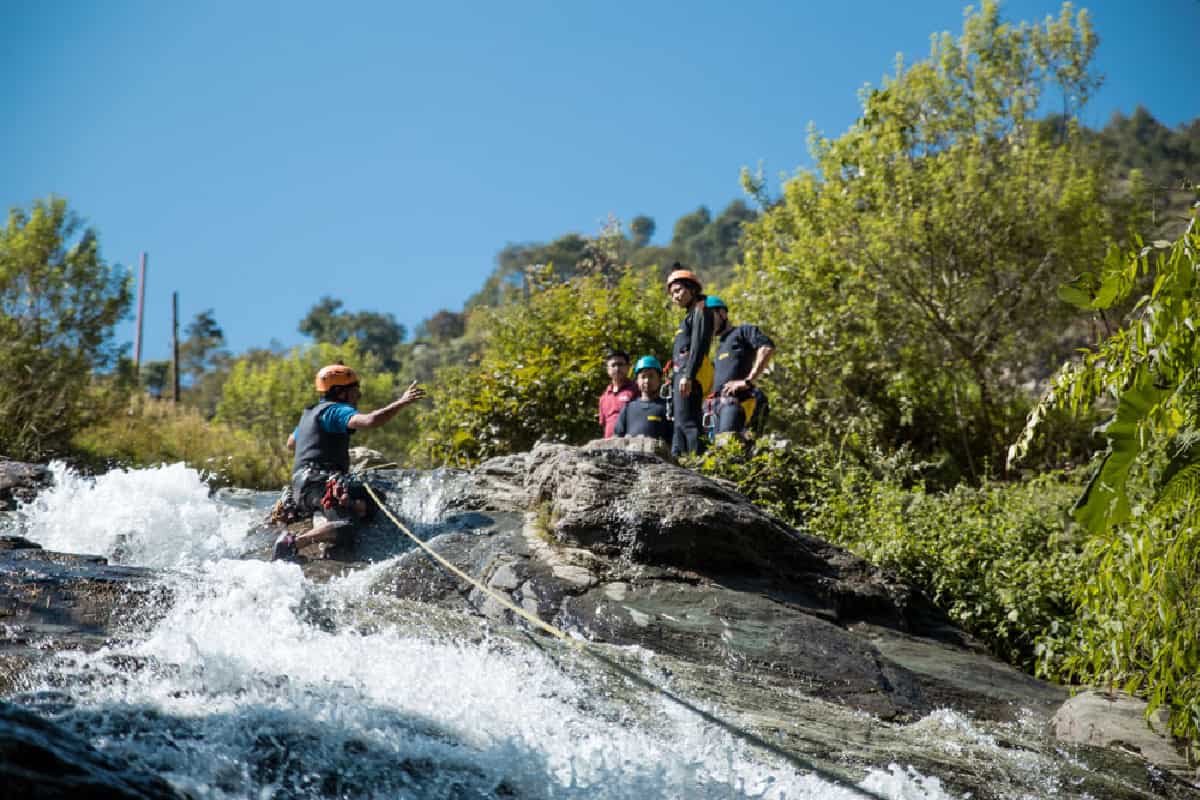- Nepal Adventure Trekking & Tour Operator
 Canyoning is an adventurous activity that involves navigating through canyons using various techniques, such as walking, scrambling, climbing, jumping, abseiling, and swimming. It encompasses various means of progressing through creek or stream-filled canyons, including hiking, scrambling, wading, boulder hopping, rock climbing, abseiling, and rappelling, all performed with safety measures.
Canyoning is an adventurous activity that involves navigating through canyons using various techniques, such as walking, scrambling, climbing, jumping, abseiling, and swimming. It encompasses various means of progressing through creek or stream-filled canyons, including hiking, scrambling, wading, boulder hopping, rock climbing, abseiling, and rappelling, all performed with safety measures.
The term "canyoneering" is often used for non-technical canyon descents, but "canyoning" and "canyoneering" typically refer to technical descents, which involve rappels, rope work, technical climbing, jumps, and swims. Canyoning is a comprehensive adventure sport that demands technical skills in stream navigation, rope work, proper gear use, and preparedness for risk mitigation. It is frequently undertaken in remote and rugged environments, necessitating navigational and wilderness travel expertise. Safety depends on judgment, competent instruction, experience, and an accurate assessment of one's abilities and knowledge of canyon conditions.
Canyons are formed by cutting into bedrock, resulting in narrow gorges with numerous drops, sculpted walls, and occasional waterfalls. Though other rock types exist, these canyons are typically carved into limestone, sandstone, granite, or basalt. The emphasis in canyoning is usually on aesthetics and enjoyment rather than sheer difficulty. Canyoning routes can vary widely in ease or difficulty and are accessible to people of all ages and skill levels.
Canyoning equipment includes climbing gear, static ropes, helmets, wetsuits, specialized shoes, packs, and rope bags. While canyoners have traditionally adapted climbing, hiking, and river running equipment, the increasing popularity of canyoning has led to the development of more specialized gear.
In Nepal, canyoning is emerging as a thrilling tourism activity, offering opportunities in various famous rivers, such as:
| Name of the River | Location | Grade | Water Temperature | Time |
| Bhul Bule Khola | Annapurna Himal | V3.A1.I | 14 | 2 h |
| Kabindra Khola | Annapurna Himal (East) | V2.A1.I | 14 | 30 m |
| Raindu Khola | Annapurna Himal (East) Marshyandi Valley, Syange Village (1,180m) | V4.A3.II | 14 | 3h 45 m |
| Sansapu Khola | Annapurna Himal (East) Marshyandi valley, Syange Village (1,180m) | V4.A3.II | 13 | 7h 30m |
| Gopte Khola | Annapurna Himal (East) Marshyandi valley, Bahundanda Village (1,200m) | V2.A1.I | 14 | 6h 30m |
| Chipla Khola | Annapurna Himal (East) Marshyandi valley, Jagat Village (1,280m) | V5.A4.IV | 13 | 6h 30m |
| Syange Khola | Annapurna Himal (East) Marshyandi valley, Syange Village (1,180m) | V6.A3.III | 13 | 7h |
| Jagat Khola | Annapurna Himal (East) Marshyandi Valley, Jagat Village (1,280m) | V6.A5.IV | 11 | 9h 30m |
| Tal Khola | Annapurna Himal (East) Marshyandi valley, Tal Village (1,700m) | V4.A4.IV | 9 | 5h |
| Jombo Khola | BaraBise- Kodari Araniko High way- Bhotekosi Valley | V2.A1 I | 13 | 3h |
| Handi Khola | BaraBise- Kodari Araniko High way- Bhotekosi Valley | V2.A1 I | 13 | 4h |
| Kabre Khola | BaraBise- Kodari Araniko High way- Bhotekosi Valley | V2.A2 II | 13 | 3h 45m |
| Galung Khola | BaraBise- Kodari Araniko High way- Bhotekosi Valley | V2.A2 II | 13 | 6h |
| Fanfung Khola | BaraBise- Kodari (15 KM North from Bahrabise) Araniko High way- Bhotekosi Valley | V4.A3 III | 13 | 6h 30m |
| Bandiba Khola | Kavre (East. Kathmandu) Sunkoshi valley | V2.A1 III | 13 | 3h |
| Tantung Khola | Kavre (South-East. Kathmandu) Sunkoshi Valley, Kallery Village – (800m) | V3.A2 III | 13 | 4h 30m |